On a clear dark night in New Hampshire, a world that’s much bigger than ours and just as mysterious appears in the sky. Besides the moon, Earth’s only natural satellite, you can spot planets — angry Jupiter, bright Venus, the many-ringed Saturn and the fiery red Mars — among glittering star constellations and clusters. Constellations rotate seasonally around the world, but the Big Dipper, for example, is always somewhere above New Hampshire, and can be seen without a telescope.
Another constellation, the gallant Roman warrior, Orion, aims his star-studded arrow at a hidden foe, while the Big Dipper dumps more stars into the sky. Tiny galaxies hover nearby. Meteor showers — pieces of rocks under intense friction — burn and glow as they fall through our atmosphere to become “shooting stars.”
Phenomenon like nebulas, giant clouds of gas and dust, stem from interstellar chaos such as the catastrophic remains of a dying supernova. New orbs are birthed there using materials from “star nurseries” like the Crab Nebula, Orion Nebula and Horsehead Nebula. You can even glimpse the Milky Way here, the road map to our place in the universe.
These galaxies and star factories were formed epochs ago, but today, views of the night sky here and around the world are dimming, hindered by artificial light from computers, phones, and on billboards, gas stations and streetlights. The Horsehead Nebula can be seen from Earth with some work, but light pollution has made it even more evasive.
Regardless, there are still plenty of New Hampshire residents who love to “stargaze” — using telescopes or the naked eye to view our solar system and everything inside it — and encouraging others to do the same.
Starry gatherings
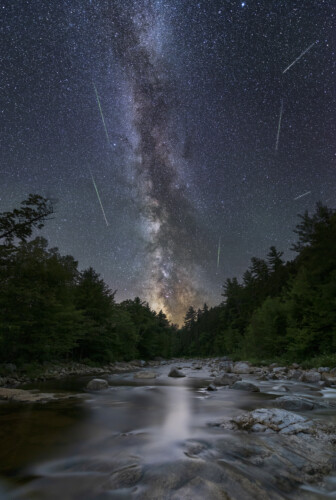
The Swift River runs some 25 miles in the White Mountains of New Hampshire. The river is a tributary of the Saco River, which flows to the Atlantic Ocean in Maine. The Perseids is a prolifc meteor shower that reaches its peak in August. It meteors appear to originate from the Constellation Persus, hence its name. This photo was taken mid-August near Rocky Gorge off the Kancamagus Highway in the White Mountains of New Hampshire.
The nonprofit New Hampshire Astronomical Society has a healthy membership of about 200, and numbers are steadily growing, thanks to public outreach and education.
For example, the late Dr. Brian Marsden, a British astronomer, once gave a talk about the inner politics that revolved around demoting Pluto to a minor planet in 2006.
Marsden was a member of the IAU Minor Planet Center, an organization that collects data about smaller bodies in the heavens, such as minor planets like asteroids, and comets — small icy bodies in the solar system that can leave a broad “tail” of light as they pass near the Sun.
Other events take place in downtown Portsmouth, where passersby can take a peek at the sky using telescopes; and present talks for local groups.
The NHAS meets monthly during “Super Stellar Fridays” at the McAuliffe- Shepard Discovery Center in Concord, and the group often brings along telescopes for the public to peruse. The society also holds free “sky watch” stargazing events at libraries as well as at Castle in the Clouds in Moultonborough.
They also conduct sky watches at the observatory at the H.A. Rey Cultural Center in Waterville Valley, where Curious George author Hans Rey lived.
One reason the author chose that area was because it had such dark skies. While there in the 1950s, Rey began redrawing constellation patterns to make them more user-friendly and easily identifiable, especially for kids. He called the book “The Stars: A New Way to See Them.”
NHAS Secretary Paul Winalski of Merrimack joined the NHAS in 2004, but has always looked up at the stars.
“My mom has pictures that I drew in nursery school of stars and planets. I’ve always been interested in what’s going on in the sky,” Winalski says.
Growing up in Connecticut, a place marked by “semi-rural cow pasture,” Winalski remembers seeing the Pleiades, or the Seven Sisters, a brilliant cluster of stars that emits a saintly blue light.
To fuel his passion, his parents bought him a telescope, where he viewed more distant objects.
Finding constellations
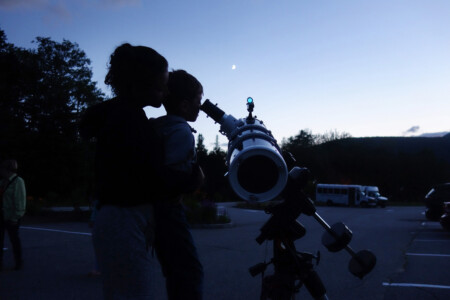
A mother and her son use a reflector telescope to check out the moon at dusk at Rey Cultural Center in Waterville Valley last July. The New Hampshire Astronomical Society has worked with elementary schools to educate schoolchildren about the night sky, and hosts sky watches to expand kids’ natural curiousity.
A good way to begin learning about the night sky, Winalski says, is to find familiar constellations. The Big Dipper may be the easiest. It’s a prominent group of stars that forms an angular, upside-down ladle, with a “handle” to its right. The constellation Orion is identified by an orderly group of three stars that form Orion’s belt in the southern part of the sky. To find the Pleiades, in the constellation Taurus, use Orion’s three-star belt as a place holder, then look up and to the right to find this bright collection shaped like a small dipper.
Though the best viewing often takes place north of the White Mountains, several places in southern New Hampshire are still ideal for gazing.
“We are actually fairly blessed in that we have probably the best skies in the whole country,” says Winalski, adding that you’ll see more when you get about 10 miles outside urban areas.
“The main thing is to get away from the artificial light. You don’t have to go too far to get reasonable skies,” Winalski says.
Winalski counts the Leonids as his favorite meteor shower for the sheer number of shooting stars that can be seen, especially every 33 years, at its height. Viewing the Leonids in November, 1998, during this apex, was an experience that stuck with him.
“I decided that if I counted fewer than 200 meteors per hour, I would go indoors because it was getting too cold. I started at midnight. And I actually went indoors at 5 a.m., and that was because the sun came up,” he says.
“One of the most spectacular sites I have ever seen,” Winalski adds.
Getting kids involved in space
NHAS member and astrophotographer Ed Ting of Amherst also became interested in astronomy as a kid. After a physics teacher told him he could make his own telescope, he researched it and made one using a mirror mined from a photocopier.
“That was the best day of school I ever had,” Ting says.
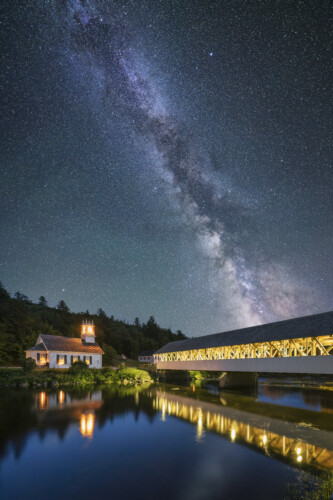
Stark is a small town located in The Great North Woods of New Hampshire. The town includes a historic covered bridge and the historic Stark Union Church that was built in 1853 as a non-denominational worship space. I took the photo in late August as the Milky Way sailed over the scenic Stark Covered Bridge, with the Stark Union Church by its side. The green on the lower left side of the Milky Way is “airglow”, a natural phenomenon caused by a faint emission of light in the atmosphere.
Though he still has that tool, today Ting uses a more advanced telescope to find possible undiscovered stars and planets in deep space, as well as to “comet-hunt.” He says amateur astronomers he calls “weekend warrior dads,” who do the latter, because there’s a chance at fame, though maybe not fortune.
“Something hit Jupiter a couple of years ago, and the professionals didn’t catch it. If you discover something that no one’s found before, they’ll name it after you. So, for a few months, everyone around the world will be speaking your name,” Ting adds.
The former president of the NHAS, Ting is also a “Solar System Ambassador,” a program through NASA’s Jet Propulsion Laboratory. The program, first proposed by a New Hampshire teacher, is a public outreach program in which volunteers spread the word about NASA’s space program and its discoveries.
Ting is working to get kids around the world interested in what’s in the night sky. Through the ACEAP, the Astronomy in Chile Educator Ambassadors Program, Ting is also part of a pilot program that’s working to bring telescopes into elementary schools in disadvantaged parts of Chile.
Ting says the country, with 330 clear nights a year, high elevation and low humidity, is one of the best places in the world to stargaze.
In New Hampshire, Ting also educates schoolchildren and hosts sky watches. When kids are around age 10 to 12, he says it’s the ideal time to teach them about the stars, planets and moon cycles.
“Kids are just naturally curious,” says Ting.
To get kids interested in these abstract concepts and make skywatching more easily accessible to the public, NHAS member and solar system ambassador Marc Stowbridge went one step further.
In 2008, Stowbridge, of South Tamworth, spearheaded the Library Telescope Program. Around 15 years ago, after the NHAS held a skywatch at Brentwood Public Library, they gifted the society with a $200 donation. Stowbridge wanted to give more people access to telescopes so that they could see what he does.
Interest in the program snowballed. Now, at least 132 public libraries around the state carry Orion StarBlast 4.5 reflector telescopes, that come with instruction booklets about constellations that patrons can borrow. The program has since spread nationwide and globally.
Today, according to the website, more than 1,000 libraries in seven countries take part in the Library Telescope Program. Stowbridge says about 3,000 telescopes are out there helping people understand the night sky.
Solar-gazing
One of Stowbridge’s favorite sky activities is “solar-gazing,” using special equipment on his telescope to locate dark sunspots on the star’s surface.
“Looking at it through these special telescopes, you can see all the features that you would never see otherwise. And it’s just a lot of fun,” Stowbridge says.
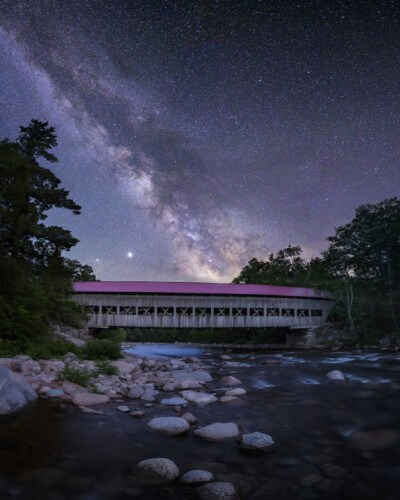
The Albany Covered Bridge is often called the most photogenic covered bridge in New Hampshire, always a photographer’s favorite at the peak of the fall season. It doesn’t hurt that it’s located along the very scenic Kancagamus Highway in the beautiful White Mountains of New Hampshire, only six miles west of the tourist-friendly town of Conway. The bridge was originally constructed here 1857, destroyed by a windstorm in 1858, and promptly rebuilt. It spans over the Swift River that flows east along the Kancamagus Highway for 26 miles. It’s considered one of the cleanest rivers in the state.
I took this photo on a July evening. The image is a composite of several frames. The foreground and bridge were photographed at dusk to limit movement and noise, while the sky was photographed later in the evening once the Milky Way was in position. The brighest star over the bridge roof is Jupiter, with smaller Saturn at its side.
The way Stowbridge explains it, viewing the stars is like going back in time.
“Well, as people are fond of saying in the business, telescopes are time machines,” says Stowbridge.
He explained that the Sun is 93 million miles away. At the speed of light, that’s about eight and a half minutes in the past. When we see the Sun (only using special safety glasses), we only see the star as it looked 8 1/2 minutes ago.
Stowbridge made more comparisons: “The Hercules cluster M 13 is 22,200–25,000 light-years away from Earth. When light from there started coming here, the Romans were having issues with the folks in Carthage. The Andromeda galaxy, that’s 2.5 million light years away. When light from there started coming here, banging rocks together was high-tech for humans,” Stowbridge says.
He described the Orion Nebula almost as you would a kaleidoscope.
“It’s taking a bunch of multicolored neon signs, putting them in a bag, jumping up and down, and throwing them up into the sky. There are pinks and greens and little speckles of baby stars all through it. It’s just lovely,” says Stowbridge.
He says the Ring Nebula is another pretty sight – a literal explosion of constantly moving color.
“It’s this delightful red and sort of pink and green smoke ring, and there’s a bright, little, tiny star in the middle that went nova two years ago. And what you’re looking at with that ring is the explosion of expanding outward,” Stowbridge says.
But for him, the real magic is when people finally spot the moon, a planet or a constellation after looking through the telescope.
“They say ‘I don’t see anything. I don’t see anything…. Oh, my God, look at that.’ And I know that they have. My favorite thing to see to telescope is somebody going, ‘Wow.’ When I’m there doing solar observing, I’m observing people. It’s just delightful fun,” Stowbridge says.
To teach kids about the Sun, he uses what he calls “technical terms.”
He’ll tell them, ‘Oh, I see the ‘freckles’ — sunspots. I see the ‘fuzzies’ — the prominences, and I see the orange peel, which are called granulation. Those are the thermal cells of plasma opening up,” Stowbridge says.
And eruptions on the face of the Sun he coined “squiggles.”
“They look like somebody took a Sharpie to the surface of the sun,” he says.
Photographing the sky
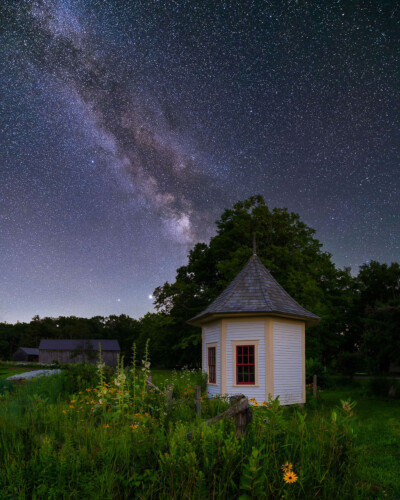
Muster Field Farm Museum is an 18th century historic homestead with restored farm buildings and a bicentennial working farm. The purpose of the restored Matthew Harvey Homestead is to preserve and promote the traditions of New Hampshire farming. Today, the farm continues to produce vegetables, fruit, flowers, hay, and cordwood. The name of the farm is attributed to its flat and open fields where militias “mustered” (i.e. a formal gathering of troops) during the 18th and 19th centuries.
I took this photo on a moonless night in July. The foreground building and flowers were photographed at dusk to ensure in-focus and noise-free subjects. The sky was photographed some two hours later after the end of astronomical twilight. The bright star above the horizon and just to the left of the tree branch is Jupiter, with Saturn to its immediate left.
Some fans, like local photographer Michael Blanchette of Bedford, travel the state and the world to photograph stars, planets and meteors showers, the aurora borealis, total solar eclipses (like the one last April) and the Milky Way.
Blanchette says while shooting the night sky can be challenging, it’s all about gathering and using light. He recommends using digital single-lens reflex (SLRs) cameras with interchangeable lenses, such as an f 2.8 aperture lens, that let in a lot of light. The faster that your lens can collect light, the sharper the stars will be in your photos, he says.
“It brings in more light faster so you can take a faster image, a faster shot, if you keep (the lens) open,” Blanchette says. You also need a tripod to keep the camera as still as possible to avoid camera shake.
Blanchette also suggests incorporating photos of the moon and sky with local landmarks, like churches, railroads, covered bridges or lighthouses that can provide fantastic backdrops for nightly shows.
“Barns look great with the Milky Way,” Blanchette says.
Blanchette says you can shoot at places like Rye Beach as long as you’re pointing your lens out to the ocean, but some beaches have spotlights that won’t help your cause. He suggests people face away from brightly lit cities and watch for smoke or haze from forest fires that can obscure the sky.
Blanchette likes photographing these faraway objects and putting them in the context of local landscapes because it takes some work to be successful at it.
“I just like the experience of being out there. It makes you feel kind of small. You are staring at the various galaxies, and it’s just pretty amazing. And I like the challenge as well.”
Winalski says stargazing — the ability to view our solar system and universe — also reminds us of our tiny place in existence, Winalski says. “We are on one planet out of eight or nine, orbiting our star, the Sun. And our star is one of 300 billion stars that are in our Milky Way galaxy, which is one galaxy out of several billion galaxies.”
Stargazing is a source of endless learning and wonderment, he says.
“The night sky is just wonderful to look at. And I find that the more I know about science, the more wonderful you become. It’s just a lot of fun, really. It’s magnificent. And if you’re religious, then this is probably the biggest gift that God has given us — our ability to see the sky.”
Visit nhastro.com for more information on upcoming events.
Stargazing resources:
Lights Out!
Light pollution map: lightpollutionmap.info
International Dark Sky Association: darksky.org
McAuliffe-Shepard Discovery Center: starhop.com
New Hampshire Astronomical Society: nhastro.com
The Rey Cultural Center: thereycenter.org
Dark Sky Places in NH: go-astronomy.com/dark-sky-parks-stargazing-state.php?State=NH
Library Telescope Program: librarytelescope.org
VisitNH-Stargazing spots: visitnh.gov/Blog/6-Spots-for-Stargazing
TheSKyLive: theskylive.com
Keene Amateur Astronomers: keeneastronomy.org
Michael Blanchette Photography: instagram.com/blanchettephotos/?hl=en
How to stargaze: science.nasa.gov/solar-system/skywatching/how-to-find-good-places-to-stargaze
EarthSky: earthsky.org
American Meteor Society: amsmeteors.org
Sky & Telescope: skyandtelescope.org
NASA’s Solar Dynamics Observatory: sdo.gsfc.nasa.gov
New Hampshire Space Grant Consortium: nhsgc.unh.edu/index.html
Online star / galaxy maps:
Hubble’s Messier Skymap:
www3.nasa.gov/skymap/messier/
APPS:
Planets
Google SkyMap
Sky Portal
SkyView Lite
Night Sky
Windy
Weather Underground
More night sky viewing:
Androscoggin Wayside Park, Errol
Coleman State Park, Stewartstown
Crawford Notch State Park, Hart’s Location
(also Crawford Notch Depot)
Dixville Notch State Park, Colebrook
Lake Francis State Park, Pittsburg
Lake Tarleton State Park, Piermont
Mollidgewock State Park, Errol
Mount Washington State Park
Umbagog Lake State Park, Errol, Tamworth
White Mountain National Forest
Francestown Barn
Pemigewasset Overlook, Lincoln
Lake Solitude, Mount Sunapee
Southern NH viewing areas:
Joppa Hill, Bedford
Holman Stadium, Nashua
Waterville Valley
Warner
Hillsborough
Muster Field Farm Museum, North Sutton
Chocorua Lake, Tamworth
Beaches (face away from bright lights)
UPCOMING METEOR SHOWERS:
Perseids: July 14 to Sept. 1
Orionids: Sept. 26 to Nov. 22
Southern Taurids: Sept. 23 to Dec. 8
Northern Taurids: Oct. 13 to Dec. 2
Leonids: Nov. 3 to Dec. 2
Geminids: Nov. 19 to Dec. 24
Ursids: Dec. 13-24
Quadrantids: Dec. 26, 2024 to Jan. 16, 2025
UPCOMING EVENTS:
Free public sessions at UNH Observatory: ceps.unh.edu/physics-astronomy/unh-observatory
Stargazing at Rey Cultural Center, all in front of the Curious George Cottage: thereycenter.org/rey-astronomy-today.html
Aug. 3 at 9:30 p.m.
Sept. 7 at 8:30 p.m.
Oct. 5 7:30 at 7:30 p.m.
Nov. 2 at 7 p.m.
Dec. 28 at 6 p.m.
Stellafane Convention of Amateur Telescope Makers, Breezy Hill, Springfield, Vermont: Aug. 1-4; stellafane.org/convention
Solar gazing at Castle in the Clouds: castleintheclouds.org/calendar-of-events/
Super Stellar Fridays at McAuliffe-Shepard: starhop.com/ssf
